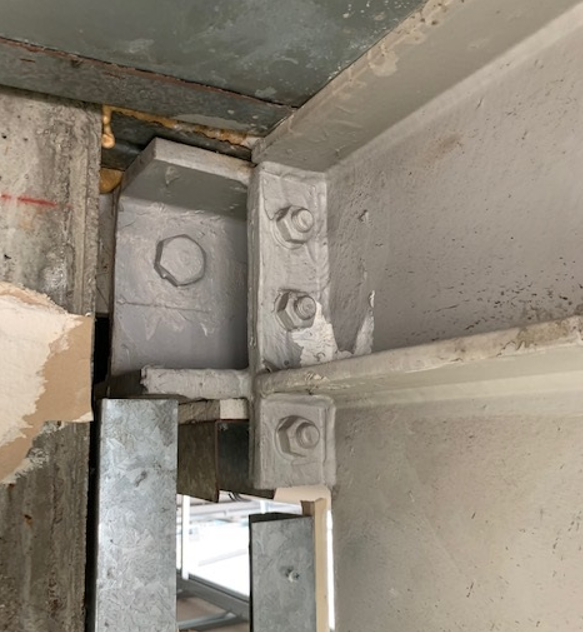'Weak link' steel connection discovered during fit-out

An unusual steelwork connection found during a fit-out of a high-specification building has prompted safety concerns. We explore the lessons learned from this incident.
A report to Collaborative Reporting for Safer Structures UK (CROSS-UK) has revealed that during an inspection of the building, which consisted of a steel frame supporting composite concrete decks with reinforced concrete (RC) core walls, a 600mm deep floor beam (plate girder compositely designed with floor slab) was supported off a 203UC trimming beam. This was found when exposing the end of a main 9m long floor beam to check its connection into the RC stair core. This, in turn, was supported off a single M30 bolt, and small fin plate into the RC core (see picture above).
The inspector had two questions: how did this connection come to be constructed, and how was it signed-off and accepted?
The reporter believes the connection might be okay under the original design loading, which they assessed to be around 240kN of shear (ULS), as a single M30 bolt could potentially carry 215kN in single shear. Therefore, depending upon original loadings and design, it is not impossible for the design reaction to be within the bolt’s capacity.
All steel structures are only as strong and reliable as their connections.
However, the detail is not shown on the as-built drawings and there are many other checks to consider such as the plate bending and weld capacity. Also, the reporter holds concerns about single bolt fixings in primary structural elements, even if the calculations stack up.
The reporter adds that in the example described in this report, the connection detail was observed on two floors that they were working on and a more robust remediation detail was implemented on site.
A report was made to CROSS UK, a confidential reporting system which allows professionals working in the built environment to report on fire and structural safety issues. The safety information provider then issued a report, with findings from its expert panel.
"All steel structures are only as strong and reliable as their connections," it said. "CROSS has previously stated that the weak link in any structure can often be the joints or fixings. Yet, in many ways, these are the parts that receive least attention in design.
"Industry standard connections are designed in standard formats proven adequate by testing and long experience, therefore special design care is required in unusual connections because load paths and exact performance are very difficult to predict.
"Single points of failure are never best practice, and many consulting engineers and steel connection designers often specify a minimum of two No.M20 bolts be adopted for each connection. Two bolts are also often required to aid with, and ensure, the safe installation of steel beams.
"The reporter rightly expresses concern over the use of a single bolt, and they should be commended on not relying on as-built drawings and instead carrying out a thorough site inspection of the existing structure. The more we are encouraged to repurpose old buildings, the more we need to be aware of historic practice and the quality of as-built drawings. This report exemplifies the importance of carrying out an intrusive site inspection."
Read more reports from CROSS UK here.








